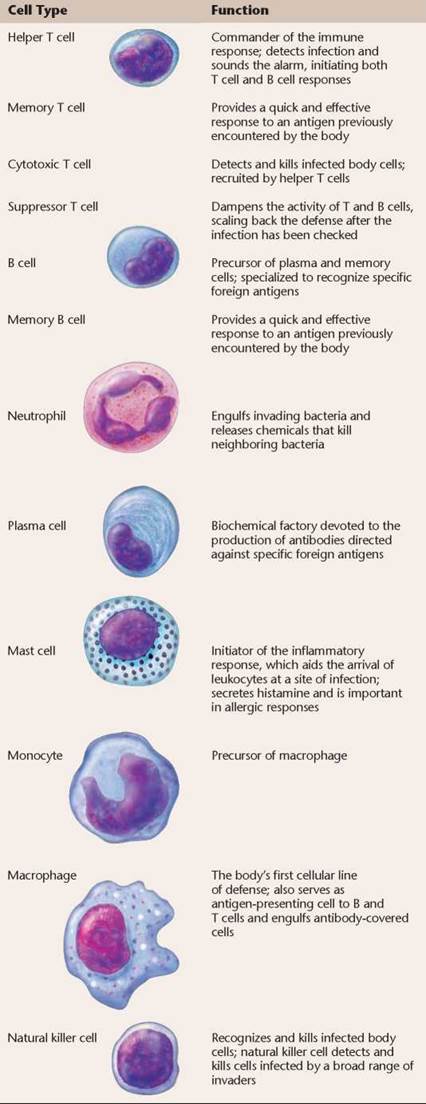THE LIVING WORLD
Unit Six. Animal Life
27. How the Animal Body Defends Itself
27.3. Specific Immunity: The Third Line of Defense
Specific immune defense mechanisms of the body involve the actions of white blood cells, or leukocytes (see also section 23.4). They are very numerous—of the 10 to 100 trillion cells of your body, two in every 100 are white blood cells! Macrophages are white blood cells, as are neutrophils and natural killer cells. In addition, there are T cells, B cells, plasma cells, mast cells, and monocytes (table 27.1). T cells and B cells are called lymphocytes and are critical to the specific immune response.
TABLE 27.1. CELLS OF THE IMMUNE SYSTEM

After their origin in the bone marrow, T cells migrate to the thymus (hence the designation “T”), a gland just above the heart (see figure 27.3). There they develop the ability to identify microorganisms and viruses by the antigens exposed on their surfaces. An antigen is a molecule that provokes a specific immune response. Antigens are large, complex molecules, such as proteins, and they are generally foreign to the body, usually belonging to bacteria and viruses. Tens of millions of different T cells are made, each specializing in the recognition of one particular antigen. No invader can escape being recognized by at least a few T cells.
Unlike T cells, B cells do not travel to the thymus; they complete their maturation in the bone marrow. (B cells are so named because they were originally characterized in a region of chickens called the bursa.) From the bone marrow, B cells are released to circulate in the blood and lymph. Individual B cells, like T cells, are specialized to recognize particular foreign antigens. When a B cell encounters the antigen to which it is targeted, it begins to divide rapidly and its progeny differentiate into plasma cells and memory cells. Each plasma cell is a miniature factory producing markers called antibodies. These antibodies stick like flags to a particular antigen wherever it occurs in the body, marking any cell bearing that antigen for destruction. So, B cells don’t kill foreign invaders directly, but rather they mark these cells so that they are more easily recognized by the other white blood cells that do the dirty work.
B cells and T cells also produce memory cells that provide the body with the ability to recall a previous exposure to an antigen and mount an attack against that antigen very quickly. As described later in this chapter, the initial specific immune response to an antigen encountered for the first time is delayed, which allows the pathogen time to infect the body. A second infection is halted much earlier due to the presence of memory cells, which respond to the pathogen more quickly.
Key Learning Outcome 27.3. T cells develop in the thymus, whereas B cells develop in the bone marrow. T cells can attack cells that carry antigens. When a B cell encounters a specific antigen, it gives rise to plasma cells that produce antibodies. Antibodies tag cells for destruction.